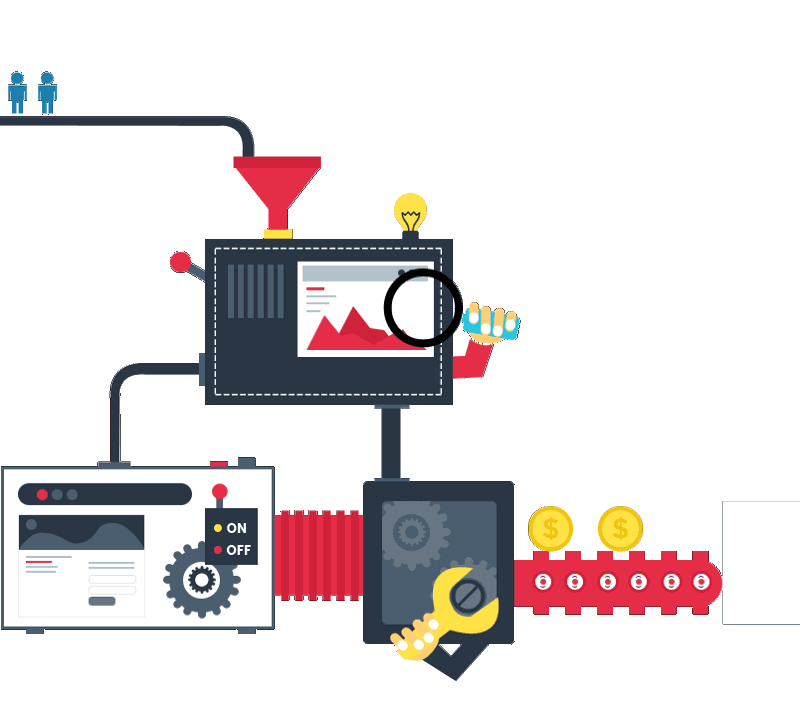
Testing and optimization are two ways that will lead your app to success. When you launch an app and it gains its market, your main purpose is to retain your existing users. Among the questions that constantly pop up into the heads of mobile app makers are “What should we do to improve our app?” and different what-if questions such as “What if we move a “Buy” button from the bottom of the screen to its top?” or “What if we change the color of the headline?” Instead of vain guesswork, you need something that can prove your idea right or wrong. This is where A/B testing should be brought into play.
A/B testing is a popular method employed in marketing and statistics as well as in the sphere of app development. It lies in conducting a comparative analysis of the existing version of an app or a web page and the updated one (with an added feature, for example). It’s aimed at figuring out which version performs better. How does A/B testing work? You assume that making some changes to your app might be beneficial for your users and you but you need real proofs that it’s going to work. Using a testing tool you make necessary alterations to your original app and then half of your users are shown the existing version of your app while the rest see it with the implemented changes. The analytics dashboard registers user’s engagement with both versions and a statistical engine analyzes user experience. As a result, you get statistics-based data using which you can make an appropriate decision.
There are different A/B testing tools but they don’t differ much from each other except for some features. Here are the most popular of them, so you can choose the one you like and can afford.
Optimizely
Optimizely is the number-one platform delivering billions of experiences on an international scale. Previously, it could test only web applications but now the tool for mobile app testing has also become available. Thus, you can use this platform for A/B testing of iOS, Android, and web apps. Optimizely offers to try its platform for free during 30 days period.
Splitforce
This tool has a wide range of testing possibilities so you can test any feature from a button color to game physics. One of the Slitforce’s advantages is that you can publish the version that stood the A/B test in one click. If your app is localized, you should know that Splitforce supports localization. The installation process is quite simple – you just copy and paste your code, and the tool will be set up in five minutes. It’s available on Android, iOS, and Unity platform.
Taplytics
Unlike many other platforms, Taplytics allows for live changes without App Store updates. Product managers and marketers can use this tool even if they don’t know how to code. Practically any feature of your app (visual, advanced) can be tested. Android and iOS support this tool; it is also available through REST API.
Apptimize
Apptimize is similar to Taplytics in terms of that it allows for making real-time changes. It means that you don’t have to resubmit to the App Store every time you make new alterations. Using this tool you can A/B test your app at a different level. Apart from revealing certain features to a particular group of users, you can also hide a certain feature from your users just during the A/P test. You may need to do so when you test which features your users are interested in or which ones are more lucrative. To use this tool, you need to know how to code, that’s why Apptimize is not intended mostly for developers. But if you can code, you’ll get the most of A/B testing with this tool available on iOS and Android.
Amazon A/B Testing
This A/B testing tool will fit the needs of both large and small teams working on their app optimization. Although this platform doesn’t have a variety of features, still it’s functional simply because it’s Amazon. If a plain UI doesn’t discomfort you, then you should use this tool. It’s available for all the Amazon apps, iOS, and Android mobile apps.
Arise
Although Arise is a typical A/B testing tool, there is something specific about it. With Arise, you can test all your users or just a particular segment. If you don’t have a technical marketing team or don’t know at least the basics of coding, it’s better not to use this tool since it’s meant mainly for developers. If you and your team believe that things are done faster with coding, Arise is for you. It’s available on iOS, Android, and PhoneGap.
Kii
Kii is a mobile backend provider and A/B Testing is just a part of the platform. However, it’s available as a separate tool and it has a lot of competitive features. Apart from all the features necessary for testing itself, there is a possibility to publish an optimal variation in one click. If you’re looking for something simpler, this tool is not for you. But if you want a plethora of features and functions, try out Kii available iOS, Android, and Unity apps.
Clutch.io
This tool has a standard set of features necessary for conducting the A/B test. Although it hasn’t been updated for a year or so, many developers and app makers keep using it for a number of reasons. It’s a native tool that works with all native apps. Since it’s an open source, you can adjust it to your needs. Clutch.io will make a simple and cheap starting point on your way towards your mobile app customization. Android and iOS are two platforms on which it’s available.
Switchboard
This is an open-source mobile A/B testing tool. Switchboard’s distinctive feature is that it can test the users both when they are online and offline. Why is it important? Because your users will see updates even if they are not connected to the Internet. Although Switchboard’s updates are few and far between, still it deserves your attention and will make a good start in experience with A/B testing tools.
Leanplum
All app marketers want to have such A/B testing tool as Leanplum. It features filters, segments, and a dashboard that provides all the necessary analytical data. The interface is quite simple – that’s a perfect match for the teams consisting of product managers and marketers who need quick results and don’t have time to seek help from the team of developers. But the main advantage of Leanplum is its availability on every platform: iOS, Android, Unity, HTML 5. It even has a REST API.
Abba
Abba is an open-source tool with a set of basic features and support of multivariate testing – everything that most app developers need. Being built on JavaScript, it will require self-hosting to control your tests and see analytics. So if your app isn’t based on JS, look for another tool.
Fliptest.io
Fliptest is currently in beta. According to the information provided on its website, this tool doesn’t require major code changes and even non-developers can easily test with it. It also allows you to create and monitor tests online. Fliptest is available only on iOS.
As you can see, different A/B testing tools have different features so it’s up to you which one would fit your specific needs best of all. It’s important to take into account a setup mode of a particular tool, its speed, affordability, usability, and accuracy of test results.


